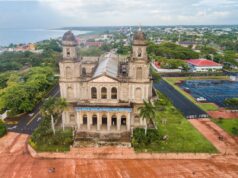This Monday July the 19th marks the 42nd Anniversary (referred to as 42/19) of the Sandinista led “Popular Revolution”, the Nicaraguan Revolution.
“The Sandinistas” as they came to be known, were named after Cesar Augusto Sandino, a national hero of the Nicaraguan resistance against the American occupation from 1927 to 1933.
The rebel group, formed in 1961 and inspired by the actions of Castro in Cuba, began to demonstrate against the US supported dictatorship of the Somoza family.
The actions of the Sandinistas led to brutal and bloody reprisals from the Somoza controlled National Guard; however, united under the FSLN banner, the Sandinistas prevailed.
In July 1979 they overthrew the Somoza dictatorship. Somoza himself fled into exile and what was left of the National Guard was dissolved.
On July 19, 1979, the Sandinistas took power in Nicaragua. The Nicaraguan Revolution had come to fruition.
The Roots of the Nicaraguan Revolution
1838 – Nicaragua becomes fully independent.
1893 – A Liberal; General Jose Santos Zelaya, seizes power and establishes a dictatorship.
1909 – US troops help depose Zelaya.
1912 to 1925 – US establishes military bases in Nicaragua.
1927 to 1933 – Guerrillas led by Augusto Cesar Sandino campaign against US military presence.
1934 – Sandino was assassinated on the orders of the National Guard commander, General Anastasio Somoza Garcia.
1937 – General Somoza (#1) elected president, heralding the start of a 44-year-long dictatorship by three members of the same family.
1956 – General Somoza is assassinated by Rigoberto López Pérez. Somoza is succeeded as president by his son, Luis Somoza Debayle (#2).
1961 – Carlos Fonseca, Silvio Mayorga (Spain) and Tomás Borge are credited with being the founders of the guerrilla movement called the Sandinista National Liberation Front (Frente Sandinista de Liberación Nacional; FSLN) in opposition to the Somoza regime. It was named after Augusto César Sandino, and its members were known as “Sandinistas”.
1967 – Luis Somoza dies and is succeeded as president by his brother, Anastasio Somoza (#3).
1972 – Managua is devastated by an earthquake that leaves 6,000 people dead and 300,000 homeless.
1974 – March, a new constitution (Nicaragua’s eighth since 1838) made it possible for Somoza to be reelected president.
1978 – Assassination of Pedro Joaquin Chamorro, the leader of the opposition; Unión Democrática de Liberación, UDEL (Democratic Liberation Union), triggers a general strike and brings together moderates and the FSLN in a united front to get rid of Somoza.
1979 – In June, the FSLN mounted its final offensive. On July 17th, Somoza resigned and fled the country.
Two days later on July the 19th 1979; the Sandinistas entered Managua and formally accepted the surrender of what was left of his army and in so doing ended the long years of Somoza rule.
The 19th of July is one of the nine Statutory Holidays in Nicaragua (Feriado; Día de la Revolución Sandinista) and celebrates the Nicaraguan Revolution. The Minister of Labor has confirmed that the national holiday gives everyone a paid day off or double time if you have to work, as per Article 66 of the Labor Code.







